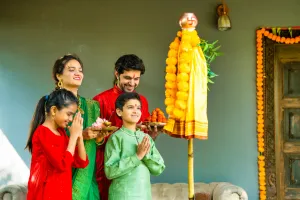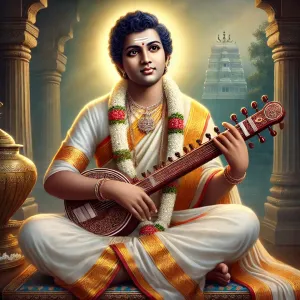In the alleys of Bihar, Jharkhand, and Uttar Pradesh, as well as in parts of Nepal the rhythmic chants and the vibrant glow of diyas (traditional oil lamps) herald the arrival of Chhath, a unique festival that transcends religion and unites communities. It is dedicated to the God Sun and Chhathi Maiya (sister of God Sun) and people observe a series of rituals and fasts during this four-day festival.
Chhath is celebrated twice in a year.
- Chaiti Chhath - It is observed in the Chaitra month of Vikram Samvat.
- Kartik Chhath - It is celebrated at a very large scale in the Kartika month of Vikram Samvat.
Kartik Chhath is more popular and celebrated by most people. It starts with Kartik Shukla Chaturthi and ends with Kartik Shukla Saptami. The four days festival breakdown as follows:
-
Nahaay Khaay (Day 1)
This is the first day of Chhath Puja. The Parvaitin (devotees) must take a holy bath, after which the entire house, its surroundings, and pathways to the Ghat are thoroughly cleaned. The Parvaitin usually cooks Sattvik Lauka Bhaat (Bottle Gourd and Bengal Gram Lentil preparation with Arva Rice Bhaat). This preparation is served to the deity in the afternoon as Bhog. This initiates the Parv and is the last meal of the Parvaitin during Chhath Puja. The food is then eaten to protect the mind from thoughts of vengeance.
-
Rasiaav-Roti/Kharna/Lohanda (Day 2)
Kharna, also known as Rasiaav-Roti or Lohanda, is the second day of Chhath Puja. On this day, the devotees do not drink even a single drop of water as offer to worship. In the evening, they eat gur ke kheer (Kheer made up of jaggery), called Rasiaav, together with Roti. Some people also eat rice, chana daal and vegitables made with Himalayan Salt (Sendha Namak).
-
Sanjh ka Arag (Day 3)
This day is spent preparing the prasad (offerings) at home, often consisting of a bamboo basket decorated with fruits, Thekua and rice laddus. On the eve of this day, the entire household accompany the devotee to a riverbank, pond, or other large body of water to make the Arghya offerings to the setting sun. The occasion can in many ways resemble a carnival. Besides the devotees and their friends and family, numerous participants and onlookers are all willing to help and receive the blessings of the worshipper.
At the time of arghya, Gangajal water is offered to God Sun and the Chhathi Maiya is worshipped with the prasad. After the worship of God Sun, Chhath songs are sung in the night and the Vrat katha is read.
After returning home the devotees perform the ritual of kosi bharai together with the other family members. They take 5 to 7 sugarcanes and tie them together to form a mandap and beneath the shade of that mandap, 12 to 24 Diya lamps are burnt and thekua and other seasonal fruits are offered. The same ritual is repeated the next morning between 3 am and 4 am, and afterward the devotees offer arghya or other offerings to the rising sun.
-
Bhor ka Aragh (Day 4)
Before sunrise on the last day of Chhath puja, the devotees must go to the riverbank, pond, or other large body of water (at the same place where they offered sandhya Arghya) to offer an arghya to the rising sun. After this, the protection of the child and the peace and happiness of the entire family is sought from Chhatti Maiya. After worship, devotees drink water and eat a little prasad to break one's fast. This is called Paran or Parana.
Rituals & Traditions
The main worshippers, called parvaitin (from Sanskrit parv, meaning "occasion" or "festival"), are usually women. However, many men also observe this festival as Chhath is not a gender-specific festival. The parvaitin pray for the well-being of their family, and for the prosperity of their children.
In some communities, once a family member starts performing Chhath Puja, they are duty-bound to perform it every year and to pass it on to the following generations. The festival is skipped only if there is a death in the family that year. If the person stops performing the ritual on any particular year, it stops permanently, and one cannot resume it. In other communities, this is not mandatory.
The prasad offerings include Thekua, Khajuria, Tikri, Kasar (and fruits (mainly sugar canes, sweet lime, coconut, banana, and many seasonal fruits) offered in small bamboo baskets. The food is strictly vegetarian and is cooked without salt (or Himalayan Salt), onions or garlic. Emphasis is put on maintaining the purity of the food.
Beyond its spiritual significance, Chhath also holds tremendous social and economic impact, breathing life into the streets and transforming the landscape. Let us embark on a journey into the heart of this mesmerizing festival and discover its awe-inspiring effects.
Enriching the Local Economy
For the small traders and artisans, Chhath is a golden opportunity to embrace economic prosperity. Vendors line up the streets, displaying an array of decorative items, traditional clothes, and mouthwatering delicacies. The demand for clay diyas, sugarcane, coconut, bamboo baskets, and other essential materials skyrocket during this festive period. The local economy blossoms, and these merchants witness a surge in their sales, uplifting their livelihoods and ensuring a steady income.
Boosting Tourism and Cultural Exchange
Chhath is not limited to the local populace; its allure transcends borders and attracts curious travelers from all walks of life. Pilgrims and tourists flock to the riverbanks to witness the grandeur of this ancient ritual, captivating them with its breathtaking beauty. The festival provides an opportunity for outsiders to immerse themselves in the rich culture and traditions of Bihar, fostering a deeper understanding and appreciation of its heritage.
Empowering Women and Breaking Barriers
Chhath is marked by a strong feminine presence, as women play pivotal roles in its celebrations. They take charge of the elaborate rituals, demonstrating their unwavering devotion and strength. This festival offers a platform for women to assert their agency and challenge societal norms. It becomes a means of empowerment, with women emerging as leaders, decision-makers, and torchbearers of tradition.
Environmental Preservation and Renewed Consciousness
As the diyas flicker along the riverbanks, an unspoken promise lingers in the air - a promise to protect and preserve our environment. Chhath reverberates with eco-consciousness, as the rituals encourage worship in harmony with nature. The strict adherence to organic materials and the practice of immersing offerings in the river symbolize a collective effort towards environmental sustainability.
Conclusion
Chhath, a festival born out of devotion and gratitude, has far-reaching social and economic consequences. Beyond the realms of religion, it unites communities, strengthens bonds, and empowers individuals. As the festival continues to evolve, its cultural significance and impact only grow stronger. Chhath is not merely a celebration; it is a testament to the resilience and unity of a land rich in heritage and hope.





